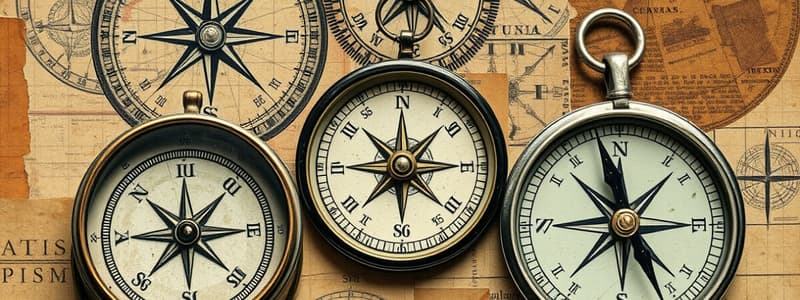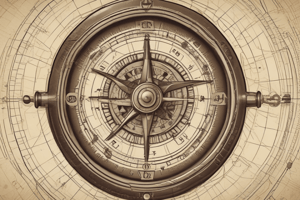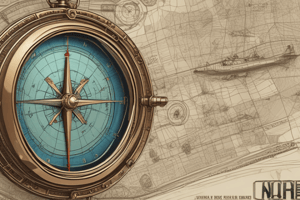Podcast
Questions and Answers
What is the primary principle of a gyrocompass?
What is the primary principle of a gyrocompass?
- It is designed to provide magnetic declination.
- It relies on Earth's magnetic field.
- It uses a magnetized needle to find magnetic north.
- It operates based on gyroscopic inertia. (correct)
Which component of a compass is responsible for indicating magnetic north?
Which component of a compass is responsible for indicating magnetic north?
- Needle (correct)
- Lubber Line
- Baseplate
- Card
What is the term for the error caused by local magnetic fields and electronic devices?
What is the term for the error caused by local magnetic fields and electronic devices?
- Bearing
- Deviation (correct)
- Direction
- Variation
Which navigation technique involves estimating one's current position based on a previously determined location?
Which navigation technique involves estimating one's current position based on a previously determined location?
What is the significance of the lubber line in compass usage?
What is the significance of the lubber line in compass usage?
What additional data can a digital compass provide?
What additional data can a digital compass provide?
Which factor does NOT affect the performance of a magnetic compass?
Which factor does NOT affect the performance of a magnetic compass?
How can one maintain the accuracy of a compass?
How can one maintain the accuracy of a compass?
Flashcards are hidden until you start studying
Study Notes
Navigational Instruments with Compasses
Types of Compasses
-
Magnetic Compass:
- Uses Earth's magnetic field.
- Consists of a magnetized needle that aligns itself with magnetic north.
- Affected by magnetic declination and local magnetic anomalies.
-
Gyrocompass:
- Based on the principles of gyroscopic inertia.
- Does not rely on Earth's magnetic field.
- Provides true north, unaffected by magnetic interference.
-
Digital Compass:
- Uses electronic sensors to detect magnetic fields.
- Often integrated into smartphones and handheld devices.
- Can provide additional data like altitude and GPS coordinates.
Components of a Compass
- Card: The circular dial marked with directions (N, E, S, W).
- Needle: A magnetized pointer that indicates magnetic north.
- Lubber Line: A fixed reference line on the compass housing used for alignment.
- Baseplate: The flat surface that stabilizes the compass, often includes a scale for measurement.
Operating Principles
- Variation: The difference between true north and magnetic north, varies by location.
- Deviation: Error introduced by local magnetic fields, often due to nearby electronic devices or metal objects.
- Bearing: The direction or angle from a reference point, typically measured in degrees.
Usage
-
Finding Direction:
- Hold the compass level and turn until the needle aligns with the north marking.
- Read the direction indicated by the lubber line.
-
Taking Bearings:
- Point the compass at the object of interest.
- Note the bearing indicated by the needle for navigation.
-
Navigation Techniques:
- Dead Reckoning: Estimating current position based on a previously determined position, factoring in speed and time.
- Piloting: Navigation using visible landmarks in conjunction with compass bearings.
Maintenance Tips
- Keep compasses away from magnetic interference.
- Regularly check for accuracy and recalibrate if necessary.
- Clean the glass and case to ensure visibility.
Limitations
- Magnetic compasses may be inaccurate near the poles due to the convergence of magnetic lines.
- Gyrocompasses require power and can be affected by mechanical issues.
- Digital compasses may need calibration for accurate readings, especially after significant movement.
Types of Compasses
- Magnetic Compass: Utilizes Earth's magnetic field with a magnetized needle that aligns to magnetic north; subject to magnetic declination and local anomalies.
- Gyrocompass: Operates on gyroscopic inertia, providing true north unaffected by magnetic fields; not influenced by external magnetic interference.
- Digital Compass: Employs electronic sensors to detect magnetic fields; commonly found in smartphones and portable devices; can display additional metrics like altitude and GPS data.
Components of a Compass
- Card: The circular face of the compass displaying directional marks (North, East, South, West).
- Needle: The magnetized element that points to magnetic north.
- Lubber Line: A fixed reference line on the compass which aids in aligning the compass direction.
- Baseplate: The flat support structure of the compass that includes measurement scales.
Operating Principles
- Variation: The discrepancy between true north and magnetic north, varying with geographic location.
- Deviation: Errors in compass readings caused by local magnetic fields or nearby metallic objects.
- Bearing: The angle or direction from a reference point, typically expressed in degrees.
Usage
- Finding Direction: Hold the compass steady and rotate until the needle points to north; read the direction in line with the lubber line.
- Taking Bearings: Aim the compass at a target object and record the angle indicated by the needle for navigation purposes.
- Navigation Techniques:
- Dead Reckoning: Estimation of position based on a prior known location, factoring in travel speed and duration.
- Piloting: Navigation that relies on visible landmarks along with compass bearings for accuracy.
Maintenance Tips
- Ensure compasses are kept away from magnetic interferences to maintain accuracy.
- Regular checks for calibration and accuracy are essential; recalibrate as needed.
- Keep the compass glass and casing clean for optimal visibility.
Limitations
- Magnetic compasses can lose accuracy near the magnetic poles due to magnetic line convergence.
- Gyrocompasses are dependent on power and can malfunction mechanically.
- Digital compasses may require recalibration after substantial movement for precise readings.
Studying That Suits You
Use AI to generate personalized quizzes and flashcards to suit your learning preferences.




